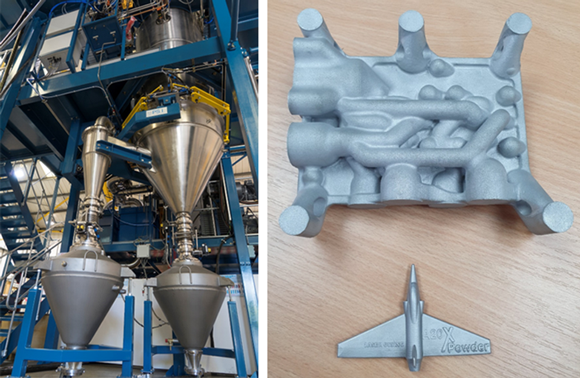PSI atomisation technology optimises aluminium powder production for Additive Manufacturing
September 29, 2022

Phoenix Scientific Industries (PSI), Hailsham, East Sussex, UK, has reported growing demand for its advanced atomising systems used to process aluminium. Through its HERMIGA atomiser range, PSI provides customers ATEX-rated equipment to produce high quality spherical aluminium powders. Particle size distribution can be adjusted to suit the end user, achieving high yields – including at the finer end of the range for applications, such as Laser Beam Powder Bed Fusion (PBF-LB) Additive Manufacturing. The HERMIGA portfolio ranges from R&D to high-capacity production scale systems, and is offered in both batch- and continuous-pour modes. This is further complemented by PSI’s Powder Metallurgy development activities and post-production powder processing technology.
Aluminium is a low density, reactive metal with an affinity for oxygen, explains PSI. In the natural world it is found in the form of compounds, with bauxite (primarily aluminium oxide) being the most common raw material for the production of pure aluminium metal (an energy intensive process requiring electrolytic reduction). As a reactive metal, aluminium is both flammable and potentially combustible. Certain chemical reactions also release flammable gases (e.g., 2Al + 3H2O = Al203 + H2). Exposed to air, aluminium will readily form a stable oxide layer and, once coated, bulk parts are commonly used in many everyday applications.
In powder form, however, the risk factor increases due to increased surface area and the potential for combustion is widely recognised. The very properties that can pose production and handling challenges can also make aluminium powders very useful for a wide range of applications including thermal spray coatings, the production of paints, Additive Manufacturing, catalysts, solid propellants, fireworks and explosives among others.
Special aluminium alloys for Additive Manufacturing
The growth of Additive Manufacturing has promoted the development of new compositions particularly suited to the unique melting and solidification characteristics of laser and electron beam AM processes. Many of these alloys contain reactive elements – such as rare earths Ti and Zr – and require the clean vacuum/inert gas melting and atomisation techniques provided in PSI’s 120 Series HERMIGA production scale atomisers. One such atomiser has recently been installed at IRT M2P’s metal powder facility at Uckange, France. Installation faced certain challenges, explained PSI, with the larger of the atomiser components being installed through the roof to fit into an existing tall building with a restricted footprint.
A20X™ aluminium alloy
PSI reports that it also worked on developing A20X™ aluminium alloy for Additive Manufacturing. This alloy has particular good high-temperature strength due the dispersion-hardening effects of its TiB2 content, and was developed through the NATEP funded ‘High Strength Aluminium Powder for additive manufacture’ (HIGHSAP) project. The consortium brought together Aeromet (lead partner), PSI, Renishaw and Rolls Royce to optimise the A20X powder as produced by atomisation to achieve properties best suited to meet the AM production requirements for aerospace, defence and automotive applications. Using PSI produced powders, the consortium additively manufactured mechanical test specimens and components. Through the consortium’s combined expertise and capabilities, the following room temperature properties were achieved; ultimate strength of 511 MPa, yield strength of 440 MPa and elongation of 13% (elevated temperature testing was also conducted). AT20X powder is now commercially available.

Post processing by fluidised bed reactor
Over the past four years PSI has entered the field of fluidised bed technology. FBR’s are extremely versatile in the processing of powders, both metallic and otherwise. Applications include heat treatments, chemical reactions and coating via chemical vapour deposition (CVD) of powders in bulk which can be scaled to commercially attractive volumes. The mass and heat transfer characteristics of a fluidised bed make them especially suitable to processing at elevated temperature while pressure can be readily adjusted to optimise the output.
The ‘Establishing a UK-based Powder Supply Chain for Engineered Powders’ (ENGPOW) project used FBR technology to process powder with the final objective, being the on-site repair of damaged aluminium airframe components via coldspray deposition. Conventional welding repair cannot be used because this would adversely affect the temper of the substrate alloy in the heat affected zone (HAZ). Cold spray repair offers a substrate compatible alternative but is hampered by low deposition efficiency when spraying relevant aluminium grades. To solve the issue, the consortium developed custom heat treatments to soften the powder, resulting greater particle deformation and therefore bonding to the substrate. To achieve this, a PSI designed FBR platform was used to solution heat treat the powder followed by extraction, rapid quenching and cold storage at -40°C to prevent the onset of natural age hardening. The consortium was comprised of PSI (lead partner), TWI and Alphatek Hyperformance Coatings with BAE Systems in an advisory capacity. An FBR operated at PSI with containment vessel removed is pictured above, along with a low temperature analogue used to establish the fluidising characteristic of the aluminium powder before heat treating at elevated temperature is shown.
Aluminium – lithium alloy powders
PSI recently developed the technology for the manufacture of equimolar aluminium – lithium alloy powders. Due to the extremely low density of Li, 534 kg/m3, alloying such a high-volume fraction faced considerable difficulties compared to the more familiar structural versions containing up to 2.45% Li by mass. This combined with the high vapour pressure of Li presented difficulties during both alloying and subsequent powder handling. Revised passivation procedures had to be developed in the face of little reliable explosivity data and the tendency to react vigorously with water. A production plant has been installed at a customer’s site and is now in operation.
PSI will exhibit at this year’s Formnext exhibition, taking place in Frankfurt, Germany, November 15-18. The company will be located in Hall 12.0 – Booth B14.
















